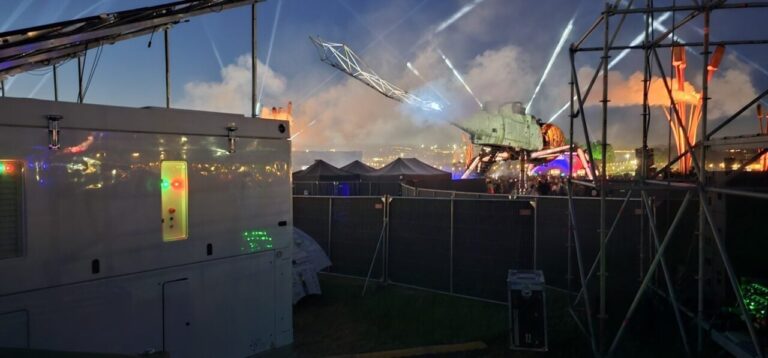Battery energy storage has powered numerous parts of Glastonbury, the world’s largest music and arts festival, including the Arcadia stage.
The five-day event with a capacity of 210,000 claims to be powered entirely by clean energy sources, including the flagship Windy Spider Field pink and purple wind turbine deployed by utility company Octopus Energy.
Much of that power comes from generators running on HVO biofuels, but many are integrated with battery storage units as backup, according to Progen Power, while a megawatt-scale solution powered one of the festival’s signature spectacles.
MSP technologies: 1MW/3MWh BESS for Arcadia stage
MSP (Multi Source Power) Technologies supplied a pre-charged battery energy storage system (BESS) to use Ecotricity to power the Arcadia stage, featuring DJ sets from Fatboy Slim, Hot Chip and Eric Prydz from inside the head of a giant metal vial structure, pictured above.
“(Ecotricity CEO) Dale Vince was confident he could help decarbonize the festival environment, so he commissioned us to build the BESS specifically for festival or portable power needs. The podium and the BESS are a phenomenal achievement,” said MSP CEO Simon Patterson Energy storage.news.
The 1MW/3MWh BESS covered the load during the three days of performances and the five days leading up to the show using HVO biofuels and a solar panel for charging. It consisted of six blocks of lithium iron phosphate (LFP) battery cells from Hithium and power conversion systems (PCS) from EPC Power.
During the show, loads jumped from under 250 kW to more than 720 kW, sometimes in the course of 20 milliseconds, something that generators would have difficulty with, according to Patterson.
“The power quality compared to a generator is chalk and cheese. If you tried those stairs with a generator, you would see them coughing black smoke. The deviation in frequency was never more than 100th of a hertz and never more than 1.8 V,” he said.
“The CO2 reduction through the use of the BESS was enormous, but the most important thing was the peace and quiet on the site outside show hours. The ground team was very enthusiastic about the arrival of the BESS, because they try to be as environmentally friendly as possible.”
The BESS is doing more festivals this summer, including Womad and a Massive Attack show, and MSP has ambitions to do many more festivals in addition to Glastonbury next year, Patterson added.
Allye: portable BESS units
Start up Allye delivered its portable BESS units in collaboration with partner Jaguar Land Rover (JLR). Approximately 25 Defender hybrid EV Range Rovers from JLR were used at the site and Allye’s BESS helped keep them charged. Allye units use second-life EV batteries and have a storage capacity of 270 kWh per unit.
Speak with Energy storage.news, Jonathan Carrier, co-founder and CEO of Allye said: “Allye is delighted to see the MAX deployed by JLR at Glastonbury to support the charging of its vehicles. It demonstrates the flexibility of the system for a range of applications for JLR, from events to prototype testing.”
“The MAX is a very versatile energy storage system that Glastonbury could use to provide sustainable energy for the music festival itself. Imagine Shania Twain or Coldplay powered entirely by clean, off-grid energy! We encourage all events and festivals that require remote power to contact Allye and make festivals truly sustainable.”
This article first appeared in our sister publication Energy-Storage.news.


